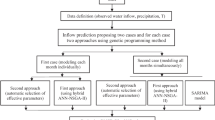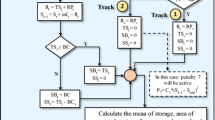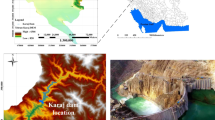Abstract
One of the most important and effective works of water resource planning and management is determining the specific, applicable, regulated operating policies of the Zayandehroud dam reservoir, as a case study, in which it should be user-friendly and straightforward for the operator. For this purpose, different methods have been proposed in which each of them has its limitations. Due to the unique capabilities of the genetic programming (GP) model, here, this method is used to determine the operating rule curves and policies of the dam reservoir. For this purpose, here, two cases are proposed in which, in the first case, each month is individually simulated and modeled. However, in the second case, all months are simulated simultaneously. A second case is proposed here to determine simple and more applicable operation rule curves. In addition, two approaches are suggested for each case in which in the first approach, the influential input variables are selected by presenting the hybrid method. In the proposed hybrid method, the artificial neural network (ANN) model is equipped with non-dominated sorting genetic (NSGA-II) algorithm leading to a hybrid method named the ANN-NSGA-II method. However, in the second approach, the influential input variables are selected automatically using the GP method. Here, the hybrid method is proposed and used to overcome the limitations of existing usual method. In other words, it is proposed to reduce the number of influential input variables of data-driven methods and select the effective ones. The obtained results of all proposed cases and approaches are presented and compared with the standard operation policy method, stochastic dynamic programming, ANN model, and NLP method. Comparison of the results shows the acceptable performance of the proposed cases and approaches. In other words, the best-obtained values of (stability index) SI index and water deficit (objective function value) are 49.3% and 32, respectively.












Similar content being viewed by others
References
Akbari-Alashti H, Bozorg Haddad O, Fallah-Mehdipour E, Mariño MA (2014) Multi-reservoir real-time operation rules: a new genetic programming approach. In: Proceedings of the Institution of Civil Engineers-Water Management, 167(10): 561–576
Ashofteh PS, Haddad OB, Loáiciga HA (2015) Evaluation of climatic-change impacts on multiobjective reservoir operation with multiobjective genetic programming. J Water Resour Plan Manag 141(11):04015030
Ashofteh PS, Bozorg-Haddad O, Loáiciga HA (2019) Application of bi-objective genetic programming for optimizing irrigation rules using two reservoir performance criteria. Int J River Basin Manag 1–11
Babaei M, Moeini R, Ehsanzadeh E (2019) Artificial neural network and support vector machine models for inflow prediction of dam reservoir (case study: Zayandehroud dam reservoir). Water Resour Manag 33(6):2203–2218
Bolouri-Yazdeli Y, Bozorg Haddad O, Fallah-Mehdipour E, Mariño MA (2014) Evaluation of real-time operation rules in reservoir systems operation. Water Resour Manag 28(5):715–729
Bourisli RI, Altarakma MA, AlAnzi AA (2018) General correlation of building energy use via hybrid genetic programming/genetic algorithm. J Sol Energy Eng 140(4):041005
Bozorg Haddad O, Afshar A, Mariño MA (2008) Honey-bee mating optimization (HBMO) algorithm in deriving optimal operation rules for reservoirs. J Hydroinf 10(3):257–264
Castelletti A, Yajima H, Giuliani M, Soncini-Sessa R, Weber E (2013) Planning the optimal operation of a multioutlet water reservoir with water quality and quantity targets. J Water Resour Plan Manag 140(4):496–510
Chang LC, Chang FJ (2009) Multi-objective evolutionary algorithm for operating parallel reservoir system. J Hydrol 377(1–2):12–20
Chang YT, Chang LC, Chang FJ (2005) Intelligent control for modeling of real-time reservoir operation, part II: artificial neural network with operating rule curves. Hydrol Process 19(7):1431–1444
Emadi A, Khademi M, Kakouei S (2016) Evaluation of yield model and standard operation policy in developing of operation rule curve (Case study: Shaheed Rajaee Dam). J Water Soil Conserv 22(6):217–229 [In Persian]
Fallah-Mehdipour E, Bozorg Haddad O, Mariño MA (2013) Developing reservoir operational decision rule by genetic programming. J Hydro Inform 15(1):103–119
French MN, Krajewski WF, Cuykendall RR (1992) Rainfall forecasting in space and time using a neural network. J Hydrol 137(1–4):1–31
Fu DZ, Li YP, Huang GH (2013) A factorial-based dynamic analysis method for reservoir operation under fuzzy-stochastic uncertainties. Water Resour Manag 27(13):4591–4610
Gong Y, Zhang Y, Lan S, Wang H (2016) A comparative study of artificial neural networks, support vector machines and adaptive neuro fuzzy inference system for forecasting groundwater levels near lake okeechobee, florida. Water Resour Manag 30(1):375–391
Haguma D, Leconte R, Côté P (2018) Evaluating transition probabilities for a stochastic dynamic programming model used in water system optimization. J Water Resour Plan Manag 144(2):04017090
Johari A, Habibagahi G, Ghahramani A (2006) Prediction of soil–water characteristic curve using genetic programming. J Geotech Geoenviron Eng 132(5):664–665
Jothiprakash V, Shanthi G, Arunkumar R (2011) Development of operational policy for a multi-reservoir system in india using genetic algorithm. Water Resour Manag 25(10):2405–2423
Karamouz M, Houck MH (1982) Annual and monthly reservoir operating rules generated by deterministic optimization. Water Resour Res 18(5):1337–1344
Karamouz M, Houck MH (1987) comparison of stochastic and deterministic dynamic programming for reservoir operating rule generation. JAWRA J Am Water Resour Assoc 23(1):1–9
Karamouz M, Szidarovszky F, Zahraie B (2003) Water resources systems analysis, vol 38. Lewis Publishers Boca Raton, FL
Karamouz M, Ahmadi A, Moridi A (2009) Probabilistic reservoir operation using Bayesian stochastic model and support vector machine. Adv Water Resour 32(11):1588–1600
Kerachian R, Karamouz M (2006) Optimal reservoir operation considering the water quality issues: a stochastic conflict resolution approach. Water Resour Res 42(12)
Lei XH, Tan QF, Wang X, Wang H, Wen X, Wang C, Zhang JW (2018) Stochastic optimal operation of reservoirs based on copula functions. J Hydrol 557:265–275
Li L, Liu P, Rheinheimer DE, Deng C, Zhou Y (2014) Identifying explicit formulation of operating rules for multi-reservoir systems using genetic programming. Water Resour Manag 28(6):1545–1565
Malekmohammadi B, Kerachian R, Zahraie B (2009) Developing monthly operating rules for a cascade system of reservoirs: application of Bayesian Networks. Environ Model Softw 24(12):1420–1432
Mishra AK, Desai VR (2006) Drought forecasting using feed-forward recursive neural network. Ecol Model 198(1–2):127–138
Mousavi SJ, Karamouz M, Asce F, Menhadj MB (2004) Fuzzy-state stochastic dynamic programming for reservoir operation. J Water Resour Plan Manag 130(JULY):460–470
Mousavi SJ, Ponnambalam K, Karray F (2007) Inferring operating rules for reservoir operations using fuzzy regression and ANFIS. Fuzzy Sets Syst 158(10):1064–1082
Nasseri M, Moeini A, Tabesh M (2011) Forecasting monthly urban water demand using Extended Kalman Filter and Genetic Programming. Expert Syst Appl 38(6):7387–7395
Nourani V, Molajou A, Uzelaltinbulat S, Sadikoglu F (2019) Emotional artificial neural networks (EANNs) for multi-step ahead prediction of monthly precipitation; case study: northern Cyprus. Theoret Appl Climatol 138:1419–1434
Paredes J, Lund JR (2006) Refill and drawdown rules for parallel reservoirs: quantity and quality. Water Resour Manag 20(3):359–376
Pawlak TP, Wieloch B, Krawiec K (2015) Semantic back propagation for designing search operators in genetic programming. IEEE Trans Evolut Comput 19:326–340
Pouladi P, Afshar A, Afshar MH, Molajou A, Farahmand H (2019) Agent-based socio-hydrological modeling for restoration of Urmia Lake: application of theory of planned behaviour. J Hydrol 576:736–748
Pouladi P, Afshar A, Molajou A, Afshar MH (2020) Socio-hydrological framework for investigating farmers’ activities affecting the shrinkage of Urmia Lake; hybrid data mining and agent-based modelling. Hydrol Sci J Spec Issue Adv Soc Hydrol 65(8):1249–1261
Raman H, Sunilkumar N (1995) Multivariate modelling of water resources time series using artificial neural networks. Hydrol Sci J 40(2):145–163
Rossi G, Ancarani A, Cancelliere A (1999) A comparison between neural network approach and multiple regression procedures for deriving reservoir operation policies. In: Proceedings of water resources planning and management. Water Resources Publications, Fort Collins, 148–161
Saadat M, Asghari K (2017) Reliability improved stochastic dynamic programming for reservoir operation optimization. Water Resour Manag 31(6):1795–1807
Saadat M, Asghari K (2018) A cooperative use of stochastic dynamic programming and non-linear programming for optimization of reservoir operation. KSCE J Civil Eng 22:2035–2042
Safavi HR, Golmohammadi MH, Sandoval-Solis S (2015) Expert knowledge based modeling for integrated water resources planning and management in the Zayandehrud River Basin. J Hydrol 528:773–789
Sandoval-Solis S, Mckinney S, Asce DC, Loucks M, D.P., and Asce, M, (2011) Sustainability Index for Water Resources Planning and Management. J Water Resour Plann Manag 137(5):381–390
Sepahvand R, Safavi HR, Rezaei F (2019) Multi-objective planning for conjunctive use of surface and ground water resources using genetic programming. Water Resour Manag 33(6):2123–2137
Sharghi E, Nourani V, Najafi H, Molajou A (2018) Emotional ANN (EANN) and wavelet-ANN (WANN) approaches for Markovian and seasonal based modeling of rainfall-runoff process. Water Resour Manag 32:3441–3456
Sharma PJ, Patel PL, Jothiprakash V (2016) Efficient discretization of state variables in stochastic dynamic programming model of Ukai reservoir, India. ISH J Hydraul Eng 22(3):293–304
Shiri J, Kişi Ö (2011) Comparison of genetic programming with neuro-fuzzy systems for predicting short-term water table depth fluctuation. Comput Geosci 37(10):1692–1701
Soghrati F, Moeini R (2020) Deriving optimal operation of reservoir proposing improved artificial bee colony algorithm: standard and constrained versions. J Hydroinforam 22(2):263–280
Spiliotis M, Mediero L, Garrote L (2016) Optimization of hedging rules for reservoir operation during droughts based on particle swarm optimization. Water Resour Manag 30(15):5759–5778
Taghian M, Rosbjerg D, Haghighi A, Madsen H (2014) Optimization of conventional rule curves coupled with hedging rules for reservoir operation. J Water Resour Plan Manag 140(5):693–698
Wu SJ, Lien HC, Chang CH (2011) Calibration of a conceptual rainfall-runoff model using a genetic algorithm integrated with runoff estimation sensitivity to parameters. J Hydroinf 14(2):497–511
Zhang J, Liu P, Wang H, Lei X, Zhou Y (2015) A Bayesian model averaging method for the derivation of reservoir operating rules. J Hydrol 528:276–285
Zhang Q, Barri K, Jiao PC, Salehi H, Alavi AH (2021) Genetic programming in civil engineering: advent, applications and future trends. Artif Intell Rev 54:1863–1885
Funding
This research did not receive any specific grant from funding agencies in the public, commercial, or not-for-profit sector.
Author information
Authors and Affiliations
Corresponding author
Ethics declarations
Conflict of interest
Both authors declare that he and she have no conflict of interest.
Data availability
My manuscript has associated data in a data repository.
Ethical approval
This article does not contain any studies with human participants or animals performed by any of the authors.
Additional information
Publisher's Note
Springer Nature remains neutral with regard to jurisdictional claims in published maps and institutional affiliations.
Rights and permissions
About this article
Cite this article
Moeini, R., Nasiri, K. Hybridizing ANN-NSGA-II model with genetic programming method for reservoir operation rule curve determination (Case study Zayandehroud dam reservoir). Soft Comput 25, 14081–14108 (2021). https://doi.org/10.1007/s00500-021-06130-4
Accepted:
Published:
Issue Date:
DOI: https://doi.org/10.1007/s00500-021-06130-4




